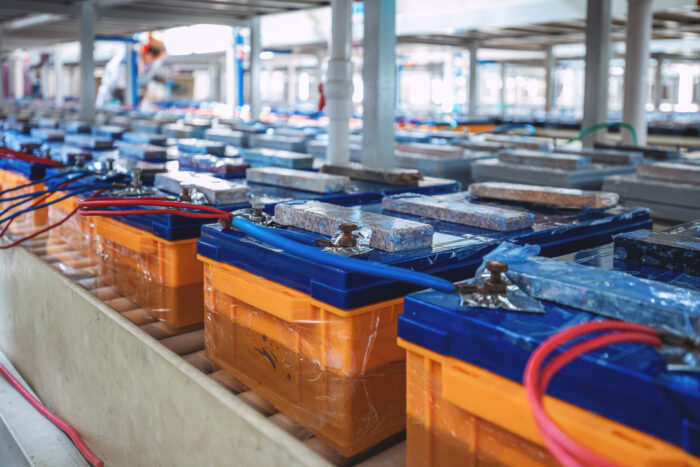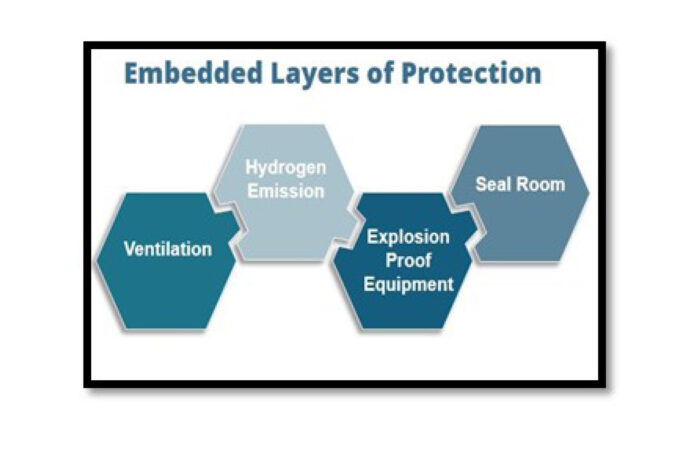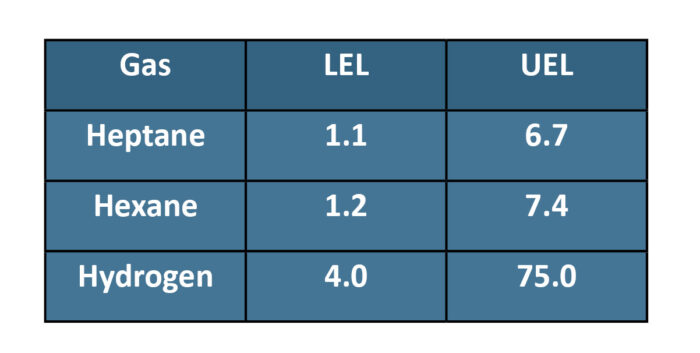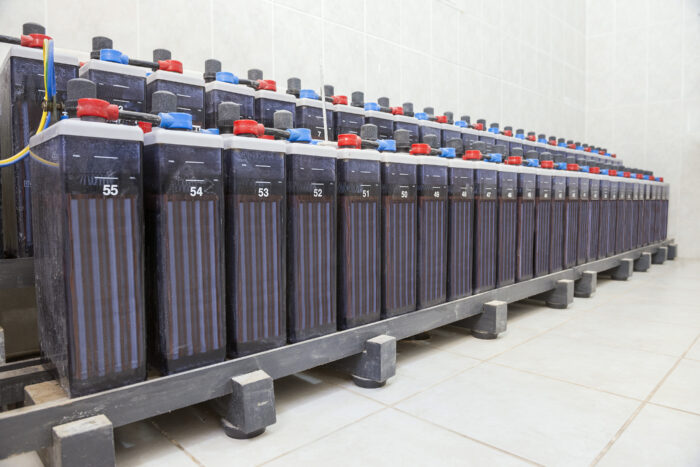Written by: Frank E. Bresnan, Sr. Electrical Engineer with Linda Ricard
Industrial facilities, such as refineries, manufacturing plants, or data centers, require backup power in the event of power outages to maintain 24/7 operations or collect critical operation parameters. For many applications, this necessitates the need to continuously use lead acid batteries in onsite battery rooms.
When charging, traditional lead acid batteries emit hydrogen from their cells. If the battery room is not properly ventilated, hydrogen accumulates in the enclosed area creating an extremely explosive environment. This accumulation, when at the proper concentration, then sets the stage for a potential explosion or fire should an ignition source ignite the hydrogen mixture in the room.
An example of the dangers hidden within the walls of a battery room is a hydrogen explosion that occurred in a data center’s Uninterruptible Power Source (UPS) battery room.
The explosion blew a 400 ft. hole in the roof, collapsed numerous walls and ceilings throughout the building, and significantly damaged a large portion of the 50,000 ft. building.
Investigators concluded that the batteries had been charging for a long period of time with no ventilation. Hydrogen continued to build up until it found an ignition source – a grounding strap on the battery racks.1
As electrical engineers specify and design battery systems, they must properly address the hydrogen gas emitted during charging periods. This is especially true for vented flooded lead calcium (lead acid) type batteries that are typically used for switchgear or UPS applications and are mounted in a separate, enclosed, battery room.
However, other type of technologies such as “sealed valve regulated” batteries can also emit large quantities of explosive gases if overcharged and therefore may require the same amount of ventilation as their vented counterparts. To prevent explosions, fires, and release of hazardous chemicals, it is critical that owners/operators of industrial facilities embed additional layers of safety in their battery rooms.
These safety steps include: (1) ensuring adequate ventilation; (2) knowing the hydrogen emission rate of the subject batteries and calculating the time for an explosive mixture to develop; (3) using explosion proof electrical equipment; and (4) sealing the wiring and room penetrations.
Steps to Enhancing Battery Room Safety
#1 Risk for Battery Room Explosions is Lack of Ventilation
Ventilation in enclosed battery rooms is a key factor in preventing events from occurring. The 2023 NEC, 480.109(A) states that “Provisions appropriate to the battery technology shall be made for sufficient diffusion and ventilation of gases from the battery, if present, to prevent the accumulation of an explosive mixture.” It is important to note that some battery technologies do not require ventilation.
In addition, mechanical ventilation is not mandated and unrestricted natural air movement in the vicinity of the battery, together with normal air changes for occupied spaces or heat removal, is normally sufficient.
If the space is confined, however, then mechanical ventilation may be required. The question that then arises is, “Is a battery room a classified location and what is the criteria depicting the determination?” Whether the battery room is classified or not, the engineer then asks the question, “Should I consider other aspects or potentials as I specify and design the system?”
API, RP500 Defines a Battery Room as:
8.2.6.7 An enclosed, adequately ventilated location (excluding battery boxes, as provided for in 8.2.6.6.2) containing batteries is classified as follows:
8.2.6.7.1 Unclassified provided: (1) calculations verify that natural ventilation will prevent the accumulation in the enclosed location of hydrogen above 25% of its LFL during normal float charge operations; and (2) the battery charging system is designed to prevent inadvertent overcharging.
8.2.6.7.2 Unclassified provided: (1) calculations verify that mechanical ventilation will prevent the accumulation in the enclosed location of hydrogen above 25% of its LFL during normal float change operations; (2) the battery charging system is designed to prevent inadvertent overcharging; and (3) effective safeguards against ventilation failure are provided.
6.3.2.4.2 Enclosed areas (room, buildings, or spaces) that are provided with at least six air changes per hour, can be considered as adequately ventilated.
This ventilation rate can be accomplished by either natural or mechanical means.
In addition, hydrogen has a LEL (lower explosive limit) of 4% by volume as shown in the table below.
Since the LEL is 4% by volume, and API sets the limit for un-classification at 25% of the LEL, in order to be considered unclassified, the hydrogen concentration must be at or below 1% (25% of 4%) of the total volume of the space.
Besides addressing ventilation in battery rooms, there are four additional layers of safety practices regarding battery rooms that engineers and designers can follow to further safeguard their client’s assets.
Verify Hydrogen Emission Rate
Verify the hydrogen emission rate with the battery and/or charger manufacturer.
Install Explosion-Proof Equipment
To enhance battery room safety, engineers will install explosion-proof equipment, such as fans and lights. The fan must be an explosion-proof fan or a fan rated to operate in a Class 1, Division 1, Group B/C/D environment, that can do six air changes per hour.
Calculate the fan’s required CFM. Specify a fan that has a contact that changes state based on fan operation. Ideally, the fan will NOT be controlled by a switch and will run 24/7. The contact can be used as a “Battery Room Exhaust Fan Failure” alarm as an effective safeguard.
Safety practices also call for installing NEMA 7, explosion proof, lighting in the battery room and an explosion proof light switch if mounted inside the room. Minimum explosion proof rated lights (and switch if inside the room) is an effective safeguard, as is using a NEMA 7 receptacle in the room if one is required.
Seal the Room
All wiring leaving/entering the enclosed battery room should be sealed with appropriate conduit/cable seals including floor and ceiling penetrations. Note that suspended ceiling tiles are not an effective barrier in the battery room. It should also be noted that some form of makeup air needs to be provided for the room. Many times, this can be accomplished by putting a louver in the bottom of the entry door to the room.
After embedding the safety layers into a battery room, the final step is to work with the client to determine if the battery room should be identified as a classified area on an area classification drawing.
Installation safeguards occurs after completing the evaluation and applying the recommended principals. However, always discuss the proposed design with the owner and obtain their buy-in prior to final design or specification.
Rules to Keep in Mind
Based on the regulations and information detailed above, there are four simple rules to keep in mind:
1. Ventilation: To be unclassified, the area must have natural or mechanical ventilation so that enough air changes take place to keep the accumulation of hydrogen at 1% or less. To be considered adequately ventilated, at least six air changes per hour are required. Note that this may be a combination of natural and mechanical ventilation rates.
2. Charging System: The calculation of 1% by volume is based on float charge operation. Float charge is the voltage level maintained by the charger to compensate for battery self-discharging or maintaining the battery voltage level by trickle charging. This is the mode that UPS’ and switchgear systems operate in the majority of the time.
The battery charging system must prevent overcharging. This is usually the case as battery chargers of today will compensate their output based on the battery voltage levels.
3. Alarm System: If a mechanical ventilation process is used then effective safeguards against ventilation failure should be provided.
4. Hydrogen Emission: Obtain from the battery and/or charger manufacturer the hydrogen evolution of the specific battery created in cubic feet of hydrogen per hour (ft3 H2 / hour). Note that a battery system will usually be comprised of multiple individual batteries connected in series and parallel to get the required voltage and backup time. It’s not uncommon to have 120 individual battery cells connected together.
Summary
While explosions and fires originating in lead acid battery rooms have traditionally been rare events compared to lithium ion battery charging facilities, the possibility still exists that built up hydrogen can lead to a hazardous incident.
Ventilation is key to preventing incidents from occurring. Following a multi-layered approach when designing a battery room enhances safety levels and ensures safe operations.
Download the Whitepaper Here →
REFERENCES
1 “Lessons Learned,” H2 Hydrogen Tools, Processing Safety Battery Room Explosion | H2tools | Hydrogen Tools, Jan. 2025.






